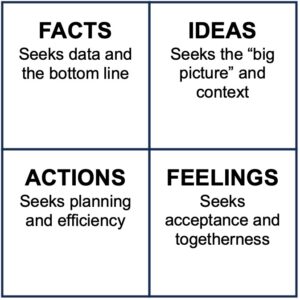As we continue our blog series, we cover the four different communication styles and how to use them to think like your audience – ultimately achieving consensus and leadership alignment.
Have you ever thought you agreed with someone but soon realized you were on different pages? It happens daily among leaders and teams, resulting in disruption and confusion. When we work with clients, we often discover the leadership team fully agrees on their strategy – but not their interpretation of how to execute it.
According to business psychologist Dr. Russ Osmond, the founder of Change Strategies International, this misalignment occurs because people develop unique thinking and vocabulary based on their experiences and communication styles. How you communicate is often different than your audience.
Osmond’s Whole Brain Model states that our brains instinctively categorize incoming communication into one of the four communication styles below.
In other words, what you mean when you communicate may be different from the message your audience hears. This creates misalignment in the business world because depending on which communication style you prefer, the word “strategy” could mean something different. See below.
These varying interpretations can lead to complications during strategic discussions. You may leave the room assuming agreement, but each person may execute the strategy differently. And each person may think the other person doesn’t understand or isn’t paying attention. The misconception lies in assuming that what is apparent to you is equally self-evident to someone else, which frequently proves inaccurate.
To foster alignment, leaders should start with a foundation of knowledge and mutual understanding. Consider this when communicating:
- Recognize there are a variety of definitions to terms or phrases. The chart below provides an example of how you can use different terms to align thinking across communication styles.
Words Dictionary: Sample terms and suggested meanings across the four communication styles.
- Share your interpretation of key terms or phrases when you communicate. Be specific and provide an example to ensure your audience understands your intent.
- Appeal to your whole audience. Try using words and phrases across each of the four communication style quadrants. This will help you select the right terms and phrases that resonate with the whole audience. In turn, you will create connections with your audience, regardless of their preferred communication style. See the example below.
Example for Kicking-Off a Strategy Meeting That Ends in Leadership Alignment
Final Thoughts
Following these simple practices will help you understand the variety of interpretations in communication, improve your interactions with others, and more effectively achieve consensus and alignment with your leaders and teams.
In the next blog of the series, we will cover how different interpretations of the strategy lead to misalignment.




